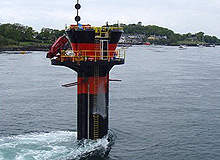
With coal and oil still providing the majority of the world’s energy needs, one might wonder what hope, if any, we have in decarbonising our economy.
Coal-fired energy generation – the most carbon-intensive energy source – accounted for 42%, or 7.9kw/h, of the world’s electrical supply in 2007 and, according to the US Energy Information Administration’s (EIA) projections, this figure could be set to grow to 15kw/h by 2035.
The International Energy Agency’s latest study, Energy Technology Perspectives 2010, also shows if the demand for fossil fuels continues to grow, energy-related CO2 emissions could double to 57 Gigatons by 2050.
Both agencies, however, have made it clear these nightmare scenarios can be reversed if countries invest heavily in alternative energies, such as nuclear and renewables, and provide incentives to attract such investment.
So far, the signs of a brighter future look promising. Renewable energy is currently the fastest growing source of electricity generation, growing 3% annually, with hydroelectric and wind power sources dominating the mix.
Investment is also growing in this immature sector. Global clean energy finance and investment rose to $243 billion in 2010, a 30% increase from 2009, according to the report, Who’s Winning the Clean Energy Race?
How well do you really know your competitors?
Access the most comprehensive Company Profiles on the market, powered by GlobalData. Save hours of research. Gain competitive edge.

Thank you!
Your download email will arrive shortly
Not ready to buy yet? Download a free sample
We are confident about the unique quality of our Company Profiles. However, we want you to make the most beneficial decision for your business, so we offer a free sample that you can download by submitting the below form
By GlobalDataChina attracted the most financers last year, with $54.4 billion being spent on renewable power, followed by Germany which received $41.2 billion in clean energy funds, a 100% increase on 2009.
Many other major economies like India and the US are also pushing forward in the race to cut carbon emissions, thanks to national policies that support renewable energy standards, and carbon reduction targets.
It’s no secret that generating power from coal or gas is still cheaper than sourcing electricity from greener technologies like solar panels, but the benefits of investing in environmentally friendly energies are growing, as several countries begin to introduce taxes which will be levied on the carbon content of fuels.
This year, the UK government confirmed in its budget address it would be the first country to introduce a carbon price floor, which will start at £16 a ton in 2013 and £30 a ton by 2020. A tax on emissions has also been proposed for countries such as South Africa, China and Australia.
These levies have the potential to move investors’ interests away from coal, oil and gas and towards cleaner sources of power. But, which technologies are expected to cut carbon emissions in such a way that they begin to reverse the effects of climate change?
Here, we profile some of the major initiatives that could make a big difference to the environment and speak to the experts behind these schemes.
A change in the wind
Wind power has blown away its competitors over the last decade, with its humble 18GW of installed capacity in 2000 growing to a mighty 159GW at the end of 2009.
The cost of building and operating turbines, however, is much higher than those for non-renewable sources. In fact, the total life-time cost of developing new offshore wind power, is up to three times the cost of conventional generation, according to Centrica CEO Sam Laidlaw, who spoke at the UK Energy Summit in June.
But, Duncan Koerbel, president for Global Services at Suzlon, one of the world’s biggest wind turbine manufacturers, believes the wind power sector will continue to bring costs down as it matures.
He says, “Could I predict that eventually wind power will be at the same price as coal? I don’t think I can make that prediction. But, would the world have the appetite to pay slightly more? Absolutely.”
Carbon infused coal power may be cheaper than wind power, but long-term, Koerbel believes our economies and global development needs to come up with a better solution. “There’s an old story that all the power in the world 150 years ago was produced from whale oil and that wasn’t sustainable, so then we switched to kerosene, and then we switched to oil and then coal, and I don’t think for the next 100 years that coal is sustainable relative to what we, as global citizens, want to sustain.”
Fuel cells
Fuel cells have been around since the 19th century, but it is only recently that global businesses have contemplated using them to generate renewable energy on a large scale.
Currently, the device, which converts chemical energy from fuel into electricity, is being used in some buildings and homes in the US at a cost of just 4.5p a kilowatt hour.
But, Sir John Banham, business leader chairman of chemicals and precious metals at Johnson Matthey, believes the system, by using methane from sewage, could play a huge role in improving the UK’s infrastructure and even run an entire fleet of buses for the London Olympics in 2012.
“The home fuel cell is 5kW, silent and you simply plug it into the gas supply. It’s about the size of a refrigerator and could operate on methane,” Banham told Knowledge INSEAD.
One major project using fuels to power its heating and cooling systems is New York’s 1 World Trade Center. UTC Power announced in 2008 that it received orders from the New York Power Authority for 12 fuel cells totalling 4.8MW of power and three other towers under construction in Manhattan.
Time for tidal
Tidal energy is a fairly niche source of power, but as quickly as it has entered the market, it has already attracted huge global interest.
There has been an explosion of tidal technologies in recent years, including the first commercial scale turbine, Seagen, which was placed off the coast of Northern Ireland, in 2008, by Marine Current Turbines.
ScottishPower Renewables is also moving forward with its ten-turbine, 10MW tidal array project, to be placed in the Sound of Islay, off the coast of Scotland.
Once installed, the Islay project is expected to save 11,300 tons of CO2 per annum, says ScottishPower Renewables’ head of renewables policy Alan Mortimer.
“In the UK it is reckoned that marine renewables (wave and tidal) can ultimately meet 20% of our electricity requirement. I’d anticipate that tidal would make up around one quarter to one half of that total,” Mortimer adds.
Unlike wind and solar power, tidal energy is predictable and reliable, requiring tides which dependably cycle twice daily with water on the move at least ten hours a day in some coastal areas.
But, does tidal energy have the potential to compete with other sources like nuclear and fossil fuels? “In the very long term yes,” says Mortimer.
“We are seeing fossil fuel prices steadily increasing in real terms and this is likely to continue. Wave and tidal costs on the other hand are at the start of a cost reduction curve, as is the case with every new technology and it is reasonable to expect that in the very long-term these costs will converge.”




